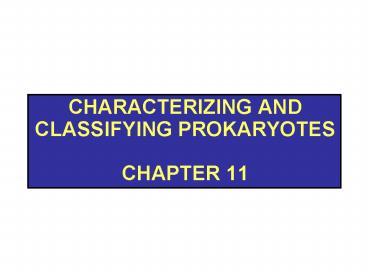Characterizing and Classifying prokaryotes chapter 11 - PowerPoint PPT Presentation
1 / 36
Title:
Characterizing and Classifying prokaryotes chapter 11
Description:
All possible habitats are exploited by some sort of prokaryote ... Actinomyces. Nocardia. Streptomyces. Actinomycetes. Figure 11.17. Gram-Negative Proteobacteria ... – PowerPoint PPT presentation
Number of Views:237
Avg rating:3.0/5.0
Title: Characterizing and Classifying prokaryotes chapter 11
1
Characterizing and Classifying prokaryoteschapte
r 11
2
Prokaryotes
- Most diverse group of organisms
- Habitats
- All possible habitats are exploited by some sort
of prokaryote - Only a few capable of colonizing humans and
causing disease
3
Morphology of Prokaryotic Cells
Figure 11.1
4
Arrangements of Prokaryotic Cells
- Result from two aspects of division during binary
fission - Planes in which cells divide
- Separation of daughter cells
5
Arrangements of Cocci Diplococci
Figure 11.6a
6
Arrangements of Cocci Streptococci
Figure 11.6b
7
Arrangements of Cocci Tetrads
Figure 11.6c
8
Arrangements of Cocci Staphylococci
Figure 11.6e
9
Arrangements of Bacilli Single Bacillus
Figure 11.7a
10
Arrangements of Bacilli Diplobacilli
Figure 11.7b
11
Arrangements of Bacilli Streptobacilli
Figure 11.7c
12
Arrangements of Bacilli V-Shape and Palisade
Figure 11.7d
13
Endospores
- Produced by Gram-positive bacteria
- Bacillus and Clostridium are examples
- Each vegetative cell transforms into one
endospore - Each endospore germinates to form one vegetative
cell - Constitute a defensive strategy against hostile
or unfavorable conditions - Endospores are not reproductive structures
14
Modern Prokaryotic Classification
- Three domains of Life
- Archaea (prokaryote)
- Bacteria (prokaryote)
- Eukarya (eukaryote)
15
Archaea
16
Features of Archaea
- Prokaryotes (no membrane bound nucleus)
- Lack Peptidoglycan in their cell walls
- Genome is circular DNA
- Histone proteins are present
- Ribosomes are more similar to bacteria than
eukaryotes - Many occupy "extreme' environments. Extremophiles
- Not known to cause disease in humans or animals
17
Halophiles
- Inhabit extremely saline habitats
- Depend on greater than 9 NaCl to maintain
integrity of cell walls - Many contain red or orange pigments protection
from visible and UV light - Extreme Halophiles require very high salt (not
just tolerant) - Most require at least 9 NaCl
- Most require 12-23 NaCl for optimal growth
- Almost all can grow at 32 NaCl
- Most studied Halobacterium salinarium
18
Extreme Halophiles
Seawater evaporation ponds
Great salt lake
African soda lake high alkalinity, high salinity
SEM of halophiles
19
Methanogens
- Convert carbon dioxide, hydrogen gas, and organic
acids to methane gas - Largest group of archaea
- Convert organic wastes in pond, lake, and ocean
sediments to methane - Some live in colons of animals are one of
primary sources of environmental methane
20
Methanogens
- CH4 (methane producers)
- Strict anaerobes
- Example genus Methanococcus
21
Methanogens
- Methanogen habitats
22
Hyperthermophiles
- Most are obligate anaerobes
- Most require S? as part of their metabolic scheme
- Example Genera
- Sulfolobus Thermococcus Pyrolobus
- Hyperthermophiles require temperatures over
80ºC - Heat stable biomolecules
23
Hyperthermophile Habitats
24
Bacterial groups
25
Phototrophic Bacteria
- Photoautotrophs
- Five groups (often grouped by color)
- Blue-green bacteria (cyanobacteria)
- Chlorophyll a (oxygenic photosynthesis)
- Green sulfur bacteria bacteriochlorophyll
- Green nonsulfur bacteria
- Purple sulfur bacteria
- Purple nonsulfur bacteria
26
Phototrophic Bacteria
Table 11.1
27
Low G C Gram-Positive Bacteria
- Clostridia
- Mycoplasma
- Bacillus
- Listeria
- Lactobacillus
- Streptococcus
- Staphylococcus
28
High G C Gram-Positive Bacteria
- Includes rod-shaped cells and filamentous
bacteria - Corynebacterium
- Mycobacterium
- Actinomycetes
- Actinomyces
- Nocardia
- Streptomyces
29
Actinomycetes
Figure 11.17
30
Gram-Negative Proteobacteria
- Largest and most diverse group of bacteria
- More diseases are caused by this group than any
other. - Five distinct classes
- Alphaproteobacteria
- Betaproteobacteria
- Gammaproteobacteria
- Deltaproteobacteria
- Epsilonproteobacteria
31
Alphaproteobacteria
- Nitrogen fixers
- Azospirillum
- Rhizobium
- Nitrifying bacteria
- Nitrobacter
- Purple nonsulfur phototrophs
- Pathogenic alphaproteobacteria
- Rickettsia
- Brucella
- Ehrlichia
- Caulobacter
32
Betaproteobacteria
- Pathogenic betaproteobacteria
- Neisseria
- Bordetella
- Nonpathogenic betaproteobacteria
- Thiobacillus
- Spirillum
33
Gammaproteobacteria
- Purple sulfur bacteria
- Intracellular pathogens
- Legionella
- Coxiella
- Methane oxidizers
- Facultative anaerobes
- Family Enterobacteriaceae
- Pseudomonads
- Pseudomonas
- Azotobacter
- Azomonas
34
Deltaproteobacteria
- Bdellovibrio
- Myxobacteria
35
Epsilonproteobacteria
- Campylobacter
- Helicobacter
36
Other Gram-Negative Bacteria
- Chlamydias
- Chlamydia
- Spirochetes
- Treponema
- Borrelia
- Bacteroids
- Bacteroides

